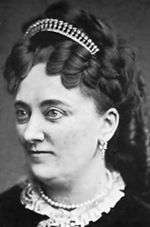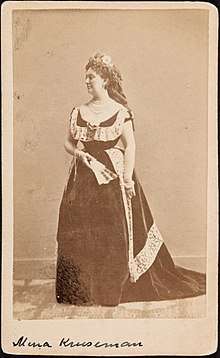Mina Kruseman
Wilhelmina Jacoba Pauline Rudolphine "Mina" Kruseman (25 September 1839 – 1922) was a 19th-century Dutch feminist, actrice and author who used to call herself Oristorio di Frama.
Mina Kruseman | |
|---|---|
 Wilhelmina Jacoba Pauline Rudolphine Kruseman | |
| Born | 25 September 1839 Velp, Gelderland |
| Died | 1922 Paris, France |
| Occupation | Writer, singer |
Mina Kruseman, was born in Velp, Gelderland as the oldest of 4 daughters of Hendrik Georg Kruseman[1][2] (1802[3]-1880) en Jennij Dorotheé Hermine Cornelie Cantzlaar[3] (1810–1859).
H. G. Kruseman, who went on to serve in the Dutch army in the Dutch East Indies, took the family with him. Her growing up with three sisters in Samarang Dutch East Indies had some influence in her later writings. But those years she had a feeling of freedom. In her in 1877 published auto-biography Mijn leven (My life) there are a few citations, where she testifies of her happy life there. In 1854 the family returned to the Netherlands. Mina developed a deep aversion against the cold, small-city narrow-minded homeland and the restrictions that were imposed by decency, convention and religion, and certainly women were thereby the most affected.
Other than her home country, she also spent a considerable part of her life in Belgium, France and United States.[4]
First performances as Stella Oristorio di Frama
Mina wanted to do something with her life. Did however not know what in the beginning. In Brussels where she lived, she was accepted at the Conservatory for voice and piano. But after one year she did quit. After the death of two of her sisters, and a broken engagement. she decides to be an artist, globe-trotting along stages. She continues her education as a singer in Paris. In Europe she has only little success. In 1871 she decides therefore to go to America. The start was difficult, but in the end she experiences as Stella Oristorio di Frama in the South of the US some success-performances. Karcilla Réna was another pseudonym used by Mina. Because the uncertain prospects she went in the summer of 1872 back to Brussels. In Paris published her first publication: a response to a woman-unfriendly piece by Alexandre Dumas, fils: Lettre a M. Alexandre Dumas fils au sujet de son livre l'Homme-femme (1872). In America she had already written her first novel. But it would take some time, before this was to be published.
Back in Holland
She started her career as a performing-artist in Holland. During her first appearance in the Hague November 1872 she reads them a chapter for from her forthcoming novel. Spring 1873 her fame in the rest of the Netherlands grows during her tour together with Betsy Perk. Other Dutch male authors had made likewise performances, reading from their own writings, into a serious source of income. Mina wanted her own economic independence, no chance of a free performance of Mina Kruseman. The text they used: Zusters. Een schetsje uit onze dagen ("Sisters. A sketch from our days.") was written by Mina especially for this occasion. It tells the story of 5 almost adult sisters, the education of girls and women's lives afterwards: waiting for a spouse, and when a marriage was not provided, a life as a spinster. Mina's tantalizing appearance and her widely acclaimed performance art was quite a happening in the early years of feminist Holland. In addition, Mina expressed severe criticism on the level of art-criticism in The Netherlands: real talents were driven out of the country: with Eduard Douwes Dekker, Multatuli as a prominent example.
Multatuli
Dekker was very pleased with this praise. He wrote to his publisher and friend G.L.Funke: I would like to thank her and bring her my compliments [5] Another letter of Dekker – very encouraging – reached Mina with the help of Funke. Mina had started reading Multatuli's Max Havelaar, during her stay in America. She found in it "strength, feeling and truth". She was inspired by this when she wrote her first novel. In it, she describes the repressive upbringing of girls, to makes them ready for marriage, and all the duties thereafter. Mina had a lot more in common with Dekker, his thoughts about morals, religion, his humor, and his fight for the weak in society. The criticism made to her, that she was too much under Dekker's influence, she did not mind that at all, just found it a biggest compliment ever. The day, she got Dekker's letter, she immediately replied to him: No letter, from anybody else, could have made me more happy, than yours [6] A few months later, she visited Dekker in Wiesbaden Germany, together with her feminist friend Betsy Perk.
School of Princes

This was the start of a close friendship between Eduard Douwes Dekker and Mina Kruseman. Mina had wishes to be an actrice, so she started a lobby to bring Dekker's play Vorstenschool (School of Princes) into the theatre. This play was published years before in 1872, as the start of IDEEN-IV. Although the play raised much attention, no theatre company in Holland dared to start with it. In 1875 Mina could make a contract with a starting theatre compagny in Rotterdam "De nieuwe Rotterdamsche Schouwburg". Mina played for some time the leading role as queen Louise. The tour was a big success. Multatuli was recognized and celebrated as a big author, he was asked on stage and applauded by the audience. Even raised ticket prices did not keep people away.
Enemies for life
It was however also the reason of the hate between Mina and Dekker in their later life.[7] After some time Mina discovered that another actrice Nans Sandrock-ten Hagen of the group was preparing to take over her Louise-role. Although at first this was denied, soon Mina was put aside. Her claim of 3000 gulden, was denied to her on 4 mei 1875 by the Rotterdam court. The new "Louise" had only little success and the tour came to an end.
Mina was very disappointed, in 1877 she published her three volumes book Mijn Leven (My Life), to close her time in Holland. Multatuli... He had always insisted, that he never had admired her, never had he any faith attached to her acting talent. Now it appeared all too obvious to the contrary. She had left a bomb for all her sworn enemies, but did not wait at all for the critics. On 1 September 1877 she said good bye to Holland and went to the Dutch East Indies for the rest of her life until her death in 1922 she never touched Dutch soil.
In one of the last pages of her book she wrote: I can look back on my past without repentance, I am happy with my present, my future I will meet without illusions, but also without fear. What do you want more?
A feminist in the tropics
Newspapers in the Dutch colonies were informed about the arrival of Mina. On 12 October 1877 the Algemeen Dagblad van Nederlands Indie mentions the plans of Mina to come and stay for 10 years. 18 October she arrived with the Princes Amalia of the Nederlandsche Stoombootmaatschappij in Batavia. At that moment also copies of her book Mijn leven were available. Soon the first reviews were published. Many blame her indiscretion, superficial, overconfidence, but usually it is considered rather positive.
Afterlife
In 1881 she did meet the writer, photographer and musician F.J. Hoffman. [8] He was a pupil of Mina, in his twenties (22) and Mina Kruseman in her forties. But Mina had a rather big house, and in this way they could keep their relation secret for the local community. Only after they left in 1883 the Dutch East Indies during their voyage to europe, a daughter was born. 5 November 1883 the Soerabaya Courant mentions the birth and the "marriage" of Mina and Frits. But nothing could be found in the Singapore marriage registers of this period. According to Mina they lived three and a half year in Naples. Here another girl was born. Both children died at a young age. The couple then settled in Boulogne-sur-Seine, a suburb of Paris which now, after the merger with the city of Billancourt, is called Boulogne-Billancourt. They lived by Hoffmans merits as a photographer and violin teacher and later, after he had lost his work as a photographer, of the music classes and an annuity of Mina Kruseman. Hoffman died in 1918. Her health worsened, she was infirm and after 1920 she almost never left her house anymore. In 1922 she died on the age of 82.
For her role as feminist she was honored by a large number of municipalities in the Netherlands, that have named a street after her including: Arnhem, Coevorden, Delft, Enschede, Hoorn, Leiden, Spijkenisse, Tiel, Venray, Venlo, Tilburg, Waalwijk, Zaanstad, a lane in Deventer, a channel in Veenendaal, a road in Tilburg or a square in Dordrecht.
Published works
- Een huwelijk in Indië (A marriage in the Dutch East Indies) :The Hague, 1873
- De moderne Judith (The modern Judith): Dordrecht, 1873
- Meester Kritiek (Master critical): Middelburg, 1874
- Mijn leven (My life): Dordrecht, 1873
- Willen en handelen (Want and actions): Fellah Damstone, Dordrecht, 1879
References
- "Mina Kruseman". Retrieved 19 June 2007.
- Huwelijksakte 1 van de Burgerlijke stand Gelderland, inventarisnummer 3239 Huwelijk tussen Hendrik G. Kruseman en Jennij D.H.C. Cantzlaar
- Geboorteakte 88 van de Burgerlijke stand Gelderland, inventarisnummer 6054 Jennij D.H.C. Cantzlaar (moeder) en Hendrik G. Kruseman (vader) op de geboorteakte van Jennij D.H.C. Kruseman
- "kruseman". Retrieved 19 June 2007.
- Multatuli, "Volledige Werken", 25 vols, Amsterdam 1950–1995, VW XV, p.698
- Mijn leven, II, 1
- Annet Mooij: Het verraad van een zielsverwant (The betrayal of a soul mate), in: De minotaurus onzer zeden (The Minotaur of our morals), Aksant, Amsterdam, 2010, ISBN 978-90-5260-376-6
- Olf Praamstra, Een Feminist in de tropen, de Indische jaren van Mina Kruseman,KITLV, 2003, Uitgeverij, Leiden, ISBN 90 6718 189 7